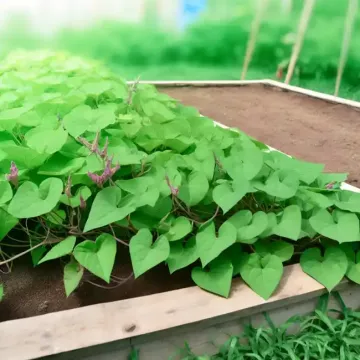Sweet potatoes are a delicious and nutritious addition to the home garden, known for their vibrant orange flesh and sweet, earthy flavor. Although they are often associated with warmer climates, gardeners in cooler regions can successfully grow them by starting early indoors or selecting shorter-season varieties. This guide will help you understand the steps to grow sweet potatoes in your garden, from planting to harvesting.
History of Sweet Potatoes
Sweet potatoes (Ipomoea batatas) have a long history of cultivation, dating back over 5,000 years in Central and South America. Native to these regions, sweet potatoes were later spread globally by explorers and traders. Today, they are a staple crop in many parts of the world, appreciated for their versatility and nutritional value.
Health Benefits of Sweet Potatoes
Sweet potatoes are not only tasty but also packed with nutrients. They are an excellent source of dietary fiber, vitamins A and C, manganese, and antioxidants. The high beta-carotene content, which gives the orange varieties their bright color, is beneficial for eye health. Additionally, sweet potatoes have a low glycemic index, making them a good option for people managing blood sugar levels.
Planting Sweet Potatoes
Sweet potatoes thrive in warm weather and require a long growing season of around 90 to 120 days of frost-free conditions. They are typically grown from "slips," which are small shoots that sprout from a mature sweet potato. You can either purchase slips or grow your own by placing a sweet potato in water or moist soil until it sprouts.
- Site Selection: Choose a location with full sun (at least 6 hours of direct sunlight daily) and well-drained, loose soil. Sweet potatoes prefer slightly acidic soil with a pH of 5.5 to 6.5.
- Soil Preparation: Sweet potatoes grow best in sandy, loamy soil. Amend heavy clay soils with compost or organic matter to improve drainage and aeration. Raised beds are also a great option for sweet potatoes, especially in areas with compacted soil.
- Planting Time: In most regions, plant your sweet potato slips 3 to 4 weeks after the last frost date when the soil temperature has warmed to at least 65°F (18°C). In cooler climates, start your slips indoors about 6 to 8 weeks before the last frost.
Growing Tips
Once planted, sweet potatoes require minimal maintenance. However, proper care can lead to a more bountiful harvest.
- Watering: Keep the soil consistently moist but not waterlogged, especially during the early growth stages. Reduce watering as harvest time approaches to prevent rot.
- Mulching: Apply mulch to retain soil moisture, suppress weeds, and keep the soil warm. Organic mulch, such as straw or leaves, works well for sweet potatoes.
- Fertilization: Sweet potatoes do not need heavy feeding. A balanced fertilizer with low nitrogen content will encourage root development rather than excessive foliage. Organic options, such as compost, can also be beneficial.
- Vine Management: Sweet potatoes produce long, vining foliage. If space is limited, you can train the vines to grow vertically on a trellis or prune them to keep them contained. However, be careful not to cut back too much, as the vines are essential for photosynthesis.
Common Pests and Problems
Sweet potatoes are relatively resistant to many pests and diseases, but some common issues can arise:
- Sweet Potato Weevils: These pests can tunnel through the tubers, causing significant damage. To prevent infestations, rotate your crops and avoid planting sweet potatoes in the same spot year after year.
- Root Rot: Overwatering or poorly drained soil can lead to root rot, which can ruin your crop. Ensure proper drainage and avoid excessive watering.
- Wireworms and Grubs: These soil-dwelling pests can damage the tubers. Regularly turning the soil before planting can help expose and reduce their populations.
Harvesting Sweet Potatoes
Sweet potatoes are ready to harvest when the leaves begin to yellow, typically around 90 to 120 days after planting. To harvest, gently dig around the base of the plant with a garden fork, taking care not to damage the tubers.
Once harvested, cure your sweet potatoes by keeping them in a warm, humid environment (about 85°F/29°C and 85% humidity) for 1 to 2 weeks. Curing allows the sweet potatoes to develop their characteristic sweetness and helps them store better.
After curing, store your sweet potatoes in a cool, dark place with good ventilation. Properly cured and stored sweet potatoes can last for several months.
Culinary Uses of Sweet Potatoes
Sweet potatoes are incredibly versatile in the kitchen. They can be baked, roasted, mashed, or even grilled. Sweet potato fries, casseroles, and pies are just a few popular dishes that showcase their sweet, rich flavor. Additionally, sweet potatoes can be used in soups, stews, and salads, offering both nutritional benefits and a touch of sweetness to savory dishes.
Growing sweet potatoes in your home garden can be a rewarding experience, offering delicious and nutritious tubers to enjoy throughout the year. With the right care, you can cultivate a successful sweet potato crop that will keep you well-supplied with this versatile vegetable. Whether you're a seasoned gardener or a beginner, sweet potatoes are a great addition to your garden, providing beauty with their lush vines and bounty with their tasty roots.

